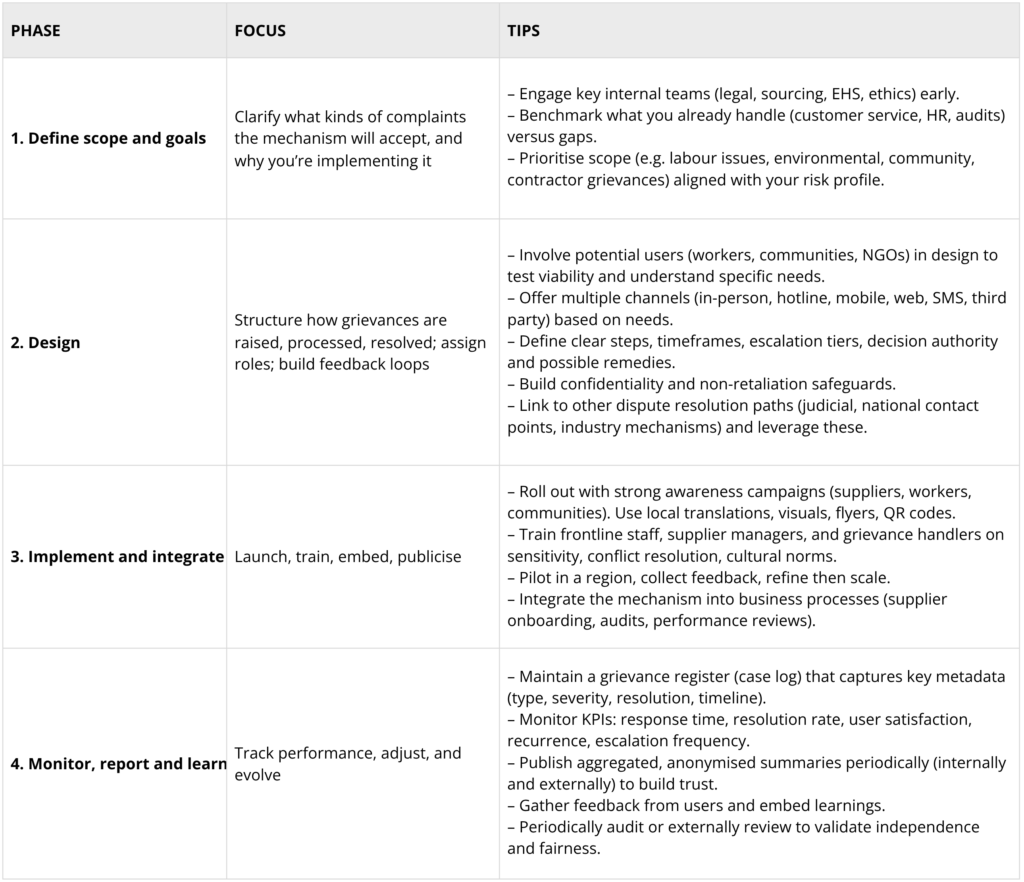
Why your Grievance Mechanism (probably) doesn’t work. And how to fix it.
SUMMARY: Many workplace grievance mechanisms fail because they’re designed for compliance, not trust. Ineffective channels, lack of follow-through, and poor user engagement mean issues go unreported or unresolved. To work, mechanisms must be user-centred, culturally sensitive, and backed by senior leadership. They should offer multiple safe reporting paths, ensure non-retaliation, and use feedback to drive systemic change.
Written by: James Lewry
Take a walk into a factory farm, construction site or supplier office, and you’ll likely find the same thing: a “grievance hotline” number on a noticeboard, a QR code leading to a form in the wrong language or a locked complaints box sitting empty.
If workers know these exist, they also know they don’t work.
In one case from Kumi’s own fieldwork, workers in a manufacturing plant believed a hotline went directly to management, the very people at the centre of their grievance, and never used it. In a development project, grievances were logged but never addressed, leaving patterns of unpaid wages unaddressed until an NGO report made headlines in international media.
These aren’t outliers. They’re examples of a common pattern, where grievance mechanisms are treated as a compliance exercise rather than a living system that detects, resolves and prevents harm.
And yet, as new regulations tighten, including the EU Forced Labour Regulation (EUFLR), the EU Batteries Regulation (EUBR), and the Corporate Sustainability Due Diligence Directive (CSDDD), the quality of these mechanisms is becoming a key factor not only for compliance, but for credibility with investors, and for supply chain resilience.
Why grievance mechanisms matter (beyond compliance)
An operational-level grievance mechanism (OLGM) is more than a whistleblowing device. It is one of the most powerful, under-leveraged tools in the compliance and risk toolbox. It’s the direct channel to rightsholders that allows a business to listen, learn and act, closing the loop between impact and remedy. When well designed, it supports:
- Early risk detection. Grievances surface issues that audits and desk reviews often miss, especially in deep or informal parts of your supply chain.
- Remedy and legitimacy. Under the UN Guiding Principles and OECD Due Diligence Guidance, companies are obliged to provide or cooperate in remediation. An operational-level grievance mechanism is a core channel for that.
- Trend insight and systemic improvement. A grievance register or database isn’t just reactive, it helps you spot patterns, root causes and prevention opportunities across operations or suppliers.
- Stakeholder confidence and reputational resilience. Publicly committing to, then demonstrating, responsiveness to concerns builds credibility and trust among stakeholders, particularly the users of the mechanism.
- Legal and regulatory alignment. Emerging mandatory human rights and environmental due diligence laws increasingly require companies to embed a grievance mechanism (or an equivalent remediation path) into their systems.
When poorly designed, however, it’s little more than a checkbox, one that can create a false sense of security until something goes wrong.
Designing effective mechanisms
Below is a practitioner-oriented roadmap for creating a grievance mechanism that can be a forward-looking tool for responsible business.

When designing your mechanism, also think about severity-based triage and escalation. Not all grievances have the same risk or urgency. Design thresholds so that more serious allegations (e.g., forced labour, severe harm) are fast-tracked to senior decision-makers or external experts.
It’s also important to offer multiple resolution pathways. Some cases may be resolved informally (e.g., through dialogue or mediation), while others may require a formal investigation or third-party intervention. Offer complainants a culturally appropriate choice.
Take local, customary considerations into account for redress. In some communities, customary mediation, elders or local dispute structures play central roles. Where compatible, the mechanism can leverage or interface with those, while safeguarding rights standards.
Finally, ensure your approach is grounded in independence and perceived legitimacy. Use neutral third parties, advisory committees or oversight bodies to ensure trust. Include stakeholder representatives or union voices.
Getting practical
Once you’ve designed your roadmap, below are some practical tips for ensuring it works and avoids common pitfalls:
- Map your risks first, then size the mechanism: Don’t create a heavyweight global grievance process from day one. Use your supply chain risk assessment to identify where grievances are most likely (geographies, supplier types, commodity sectors). Focus your initial investment there, then scale gradually.
- Leverage technology, but don’t over-rely on it: Case management platforms, hotlines, mobile apps, and chatbots can help scale the mechanism and track performance. But technology alone doesn’t guarantee trust: people must feel safe using it and understand that their grievance has been heard and that there is a remediation plan. Low-tech, people-centric channels remain essential.
- Training is vital: Your mechanism will fail if those interacting with it don’t understand context, how to interview complainants with sensitivity, or how not to intimidate. Include role-play, cultural awareness, anonymity protocols, and de-escalation techniques.
- Use feedback loops in your compliance and sourcing decisions: Don’t view grievance resolution as an isolated “end state.” Feed insights into your supplier due diligence, audit schedules, capacity-building, remediation plans and corrective action follow-ups.
- Ensure remedy is meaningful and proportionate: Remedial actions should aim to restore affected persons to the position they would have been in had the violation not occurred. Remedies may include financial compensation, medical or legal assistance, reinstatement, training, public apology or system reforms.
- Guard against retaliation: A complaint mechanism is worthless if users fear backlash. In Kumi’s experience, this is one of the main reasons why rightsholders don’t raise issues. Each phase (reporting, investigation, outcome) must enforce non-retaliation provisions. Anonymous or confidential reporting options help, but anonymity should not block follow-up inquiries.
- Use outcome transparency (ensuring privacy): Publishing anonymised summaries of the number, types, and resolution times of grievances helps demonstrate accountability and builds confidence in the mechanism.
- Be adaptive, iterative, and patient: You won’t get it perfect on day one. Use pilot runs, collect user feedback, and learn and refine. Plan for periodic external reviews.
But don’t do this…
Many grievance mechanisms fail not because they are absent, but because they are designed in isolation. When compliance or legal teams craft systems without engaging the users – workers, communities, and contractors – they risk creating something that looks robust on paper but falls flat in practice. A grievance process that ignores cultural norms, language barriers, or power dynamics will never earn trust, no matter how well-intentioned. Effective mechanisms are built through dialogue, not dictated through policy.
Even when mechanisms exist, over-engineering can also quietly undermine them. Complex forms, jargon-heavy procedures, or reliance on digital tools that users don’t understand or can’t access make the process intimidating rather than empowering. Don’t make the mistake of assuming that external audits or periodic inspections will uncover issues. Grievances often arise around sensitive topics that people are unwilling to raise in front of auditors. Without simple, safe, and confidential routes to speak up, problems remain buried until they escalate into crises.
Finally, even well-used mechanisms falter when they lack institutional muscle and follow-through. Without visible senior-level backing, grievance systems are dismissed as box-ticking exercises, run by overstretched teams with no real authority to deliver remedy. When complainants never receive feedback or see evidence of change, confidence evaporates, and the mechanism becomes irrelevant. Worse still, when data from individual cases isn’t analysed for patterns or root causes, organisations lose the chance to address systemic issues. A credible grievance mechanism should have both teeth and transparency; able to act, to resolve, and to learn.
In summary: Listen, act and learn
A grievance mechanism that nobody trusts is worse than having none. It breeds silence, not safety. As human rights and environmental due diligence requirements evolve, grievance mechanisms will increasingly define which companies genuinely learn from risk. It’s not about having a hotline; it’s about earning trust and acting on what you hear. Leading companies understand this and use grievance channels as valuable sources of insight in their due diligence systems.
Kumi works with businesses to design and test grievance mechanisms that are credible, trusted, and that close the loop between impact and remedy. We understand that a grievance mechanism has to work for rightsholders in the real world, not just on paper.

